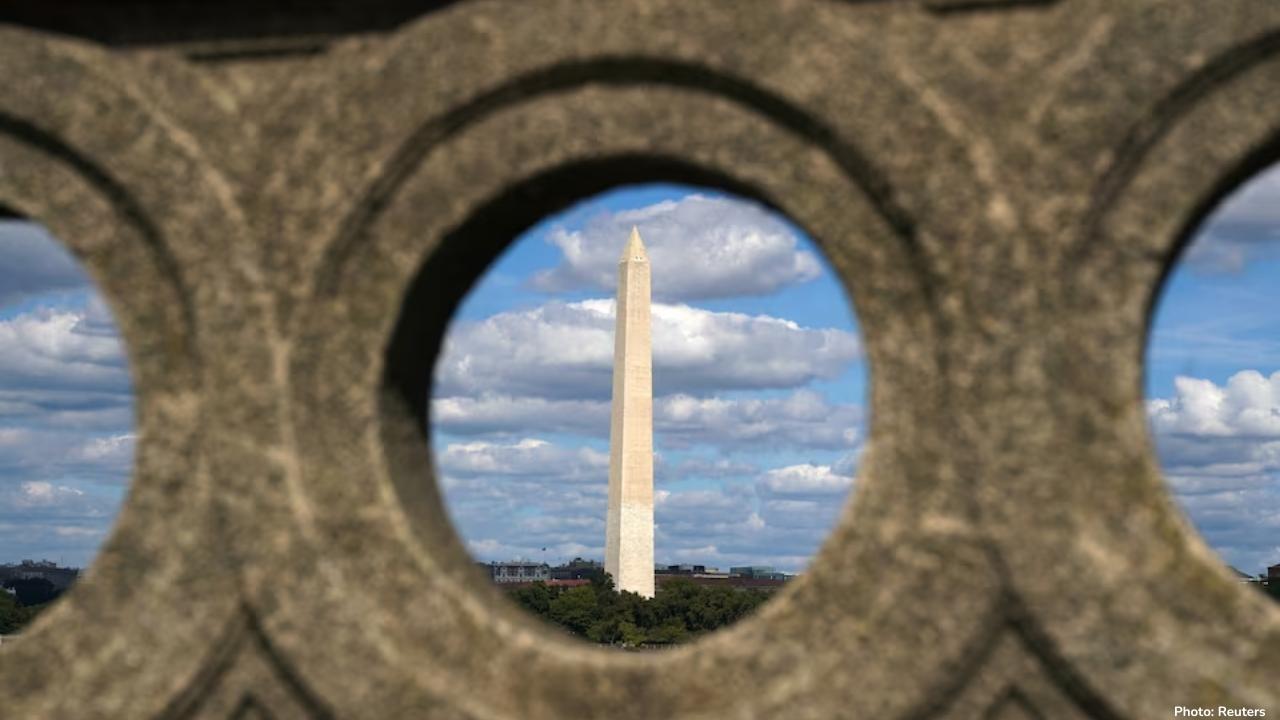
Post by : Monika
On October 2, 2025, President Donald Trump scheduled discussions with Russell Vought, the Director of the Office of Management and Budget (OMB), about potential funding cuts to federal agencies.
This announcement comes at a time when the United States is facing a government shutdown, which began on October 1 due to a budget impasse in Congress. The situation has created uncertainty for millions of federal employees and disrupted various government services across the country.
Background of the Government Shutdown
The shutdown occurred because Congress failed to approve a new budget for the fiscal year, leaving a large portion of government operations without funding. A government shutdown in the United States happens when lawmakers cannot agree on spending levels for the federal government.
During such times, non-essential federal employees are furloughed, meaning they are temporarily sent home without pay, while essential personnel, including military members, continue working, often without immediate pay.
It is estimated that roughly 2 million federal workers are affected. Among them, about 750,000 have been furloughed, while others, like members of the military or law enforcement, are required to continue working without immediate compensation.
Programs like Social Security, Medicare, and interest payments on the national debt continue uninterrupted, as these are considered mandatory spending. However, many other services, including research projects, regulatory work, and administrative programs, have been temporarily halted.
Trump's Plan and Focus on Agency Cuts
President Trump’s discussion with OMB Director Russell Vought centers on identifying agencies for funding reductions, particularly those that Trump believes are aligned with Democratic priorities. Trump has repeatedly described certain federal agencies as "Democrat Agencies" and has expressed a desire to reduce their funding or limit their influence.
Project 2025, led by conservatives, aims to streamline government operations and reduce federal involvement in certain programs. Russell Vought has been heavily involved in this initiative and previously served as OMB Director during Trump’s first term. The project emphasizes cutting federal bureaucracy, particularly in agencies that are perceived to promote Democratic policy goals.
Reactions to Potential Agency Cuts
The announcement of potential agency cuts has drawn reactions from different corners of the political spectrum. Democratic lawmakers have expressed strong criticism of these plans. Senator Patty Murray, a senior Democrat on the Appropriations Committee, stated that firing federal workers would not resolve the legislative deadlock and would unfairly punish public employees. She emphasized that government employees perform essential functions and should not be targeted as part of political disputes.
On the other hand, the White House has signaled that Trump may proceed with layoffs and funding cuts. Karoline Leavitt, a White House spokeswoman, stated that the administration could implement these reductions but did not provide exact figures or timelines.
Federal employee unions have also responded. Several unions filed lawsuits to prevent mass layoffs and protect the rights of workers. Courts have allowed the administration to continue the process while legal challenges are being considered. The legal and political battles surrounding these potential cuts have intensified the uncertainty created by the shutdown.
Impact on Federal Workers and Services
The ongoing government shutdown has significant consequences for federal workers and services. Many employees are experiencing delayed paychecks or unpaid leave, which affects their families and communities. Essential services, such as national security operations, air traffic control, and emergency management, continue but place financial and emotional strain on workers.
Other services, including scientific research, public health initiatives, regulatory oversight, and administrative functions, have slowed or paused entirely. For example, agencies that monitor environmental protections, workplace safety, or public health programs may temporarily stop operations, affecting communities that rely on these services.
The shutdown also affects the economy. Federal employees who are furloughed or unpaid may reduce their spending, which can impact local businesses and economic activity. Delays in federal projects or programs can have broader consequences for state and municipal governments, as well as private contractors that depend on federal funding.
Political Context and Strategy
The discussions between Trump and OMB Director Vought occur in the context of heightened political tensions. The government shutdown is a direct result of Congressional gridlock, where lawmakers from different parties cannot agree on spending priorities.
Trump’s strategy of targeting certain agencies for funding cuts aligns with his broader political goals of reducing federal influence in areas dominated by Democratic policy priorities.
While this approach is controversial, it serves a political purpose for Trump, signaling to his supporters that he is actively working to reduce the size of government and challenge agencies he perceives as partisan. At the same time, these actions risk further deepening the political divide and prolonging the shutdown, as lawmakers debate the legality and fairness of cutting funding or firing employees.
Project 2025 and Long-Term Goals
Project 2025 is a key element in understanding Trump’s approach to agency cuts. This initiative aims to create a smaller, more streamlined federal government with less bureaucracy. Supporters argue that the federal government is too large and inefficient, and that downsizing certain agencies will save taxpayer money and improve government performance.
However, critics warn that indiscriminate cuts could harm essential services, reduce oversight, and leave communities vulnerable in areas such as healthcare, public safety, environmental protection, and infrastructure. Balancing the goal of smaller government with the need to maintain critical services is a central challenge for the administration.
Legal and Administrative Considerations
Implementing large-scale agency cuts and firing federal employees requires navigating complex legal frameworks. Federal employees have protections under civil service laws, and abrupt terminations may be challenged in court. Funding reductions must also comply with budgetary rules and congressional approval in many cases.
The administration’s discussions with the OMB are focused on identifying areas where cuts are legally and administratively feasible. This includes evaluating the mission of each agency, the impact of budget reductions, and the potential consequences for federal operations and public services.
Potential Consequences for the American Public
If significant funding cuts are implemented, the American public could experience disruptions in federal services. These disruptions could affect programs such as public health, transportation, environmental regulation, education, and social services.
For example, agencies that provide grants to local communities, fund research programs, or oversee safety regulations could see delays or reductions in their work. This would impact citizens who rely on these programs for daily living, safety, and employment.
At the same time, proponents of the cuts argue that reducing bureaucracy and focusing resources on essential services could improve government efficiency and reduce waste. The debate highlights the tension between political priorities, budgetary constraints, and the needs of the American public.
Looking Ahead
The outcome of Trump’s discussions with OMB Director Vought will shape the immediate and long-term future of federal agencies. If cuts are approved, they could lead to reduced staffing, program delays, and changes in federal operations.
The government shutdown will continue to put pressure on lawmakers, federal employees, and citizens until Congress passes a new funding bill or the administration takes executive action. The combination of political negotiations, legal challenges, and administrative decisions will determine how quickly the government can resume normal operations.
Observers predict that the shutdown could extend for days or even weeks if agreements are not reached. In the meantime, discussions about federal agency funding, layoffs, and Project 2025 will remain at the forefront of political debates in Washington.
President Donald Trump’s planned discussions with OMB Director Russell Vought highlight a critical moment in U.S. governance. By focusing on funding cuts to agencies he associates with Democratic priorities, Trump is using the ongoing government shutdown to pursue his policy goals of reducing federal influence.
The consequences of these actions will affect federal employees, government operations, and public services nationwide. While supporters argue that these moves are necessary for a smaller, more efficient government, critics warn that essential services could be disrupted, and federal workers unfairly targeted.
As negotiations continue, the situation illustrates the complexities of managing government operations, budgetary constraints, and political priorities in a divided Congress. The outcome will likely influence federal policy, agency operations, and the broader political landscape for months to come.










Traffic Control Measures Announced for A.R. Rahman Concert at IGI Stadium
Delhi Traffic Police introduces measures near IGI Stadium for A.R. Rahman's concert on Saturday even

Kim Woo-bin and Shin Min-a Tie the Knot After a Decade Together
Actors Kim Woo-bin and Shin Min-a celebrated their marriage in an intimate ceremony in Seoul, markin

Rohit Sharma Set to Play Initial Matches in Vijay Hazare Trophy for Mumbai
Rohit Sharma joins Mumbai’s squad for the opening two Vijay Hazare Trophy matches, spearheaded by Sh

Flight Disruptions at King Khalid International Airport
Friday's operations at King Khalid Airport in Riyadh were hampered by delays and cancellations due t

Kavem Hodge Achieves Second Test Century Against New Zealand
Kavem Hodge's unbeaten century leads West Indies to 381-6, evading follow-on against New Zealand in

Security Heightened in Bangladesh Following Youth Leader's Assassination
In response to the murder of youth leader Sharif Osman Hadi, Bangladesh elevates security measures a